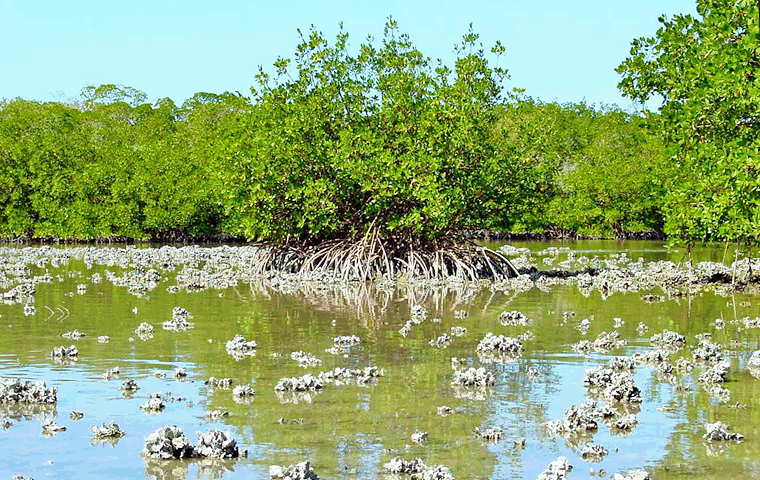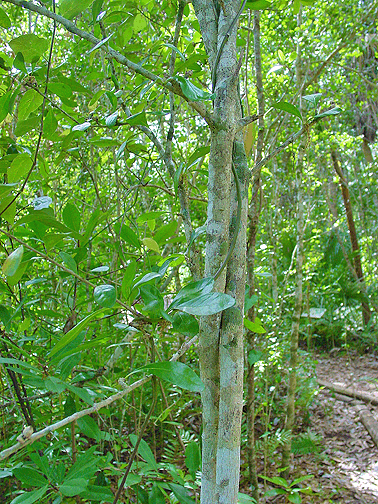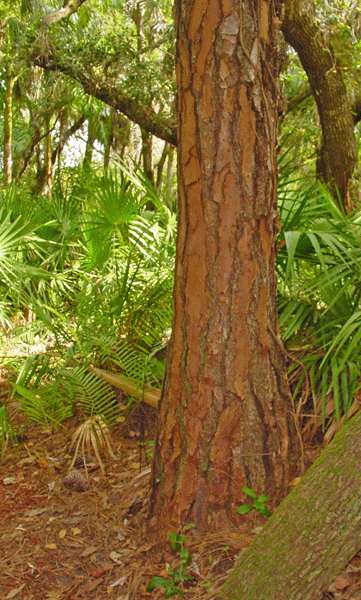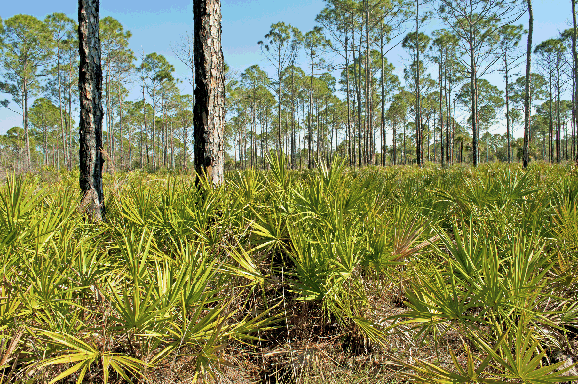Mangrove Estuary
 Mangrove estuaries are located where freshwater, originating in rivers and streams, meets ocean water. At the Conservancy of Southwest Florida Nature Center, the mangrove estuary that borders the property is brackish. Salt water from Naples Bay mixes with fresh water originating at inland regions of the Gordon River watershed.
Mangrove estuaries are located where freshwater, originating in rivers and streams, meets ocean water. At the Conservancy of Southwest Florida Nature Center, the mangrove estuary that borders the property is brackish. Salt water from Naples Bay mixes with fresh water originating at inland regions of the Gordon River watershed.
The term mangrove is given to more than 40 different tree species around the world. Mangroves live in both fresh and salt water in regions 28 degrees North and South of the Equator. South Florida is the only region of the United States where mangroves are a native species. Three mangroves exist in Southwest Florida: the red (Rhizophora mangle), the black (Avicennia germinans), and the white (Laguncularia racemosa). Each of these species can be seen at the Conservancy of Southwest Florida Nature Center.
All mangroves live in the intertidal zone, and can be considered to be living on the edge of both terrestrial and aquatic environments. Organisms that live in a brackish mangrove estuary have adapted to survive salty conditions that can change very rapidly. Tidal fluctuations, especially extreme during full and new phases of the moon, flush nutrients through the system. Low tide exposes the roots of the mangroves and the organisms that live on them. Heavy rainfall lowers the salinity of the estuary and can stress many of its organisms. Animals that typically live in the mangrove estuary include clams, snails, starfish, sea urchins, juvenile and adult fish, snakes, birds, otters, and manatees.
Mangroves have many important functions in the estuary:
1) Leaves fall into the water and become food for microorganisms at the base of an extensive food web that includes shell fish, fish, birds, and mammals. Click here to see the food web.
2) Tree roots buffer wave energy, helping reduce soil erosion and storm damage.
3) Roots and branches provide habitat for birds to perch and nest.
4) Roots provide habitat for oysters, snails, crabs, and fish.
5) Historically mangroves were used by Native Americans as a safe haven during storms.
Today, throughout the world, mangrove estuaries are among the most threatened habitats on earth, with rates of loss greater than those of rainforests and coral reefs.
Hardwood Hammock
 Hardwood hammocks are typically cool, shady, and slightly higher in elevation than wetlands.
Hardwood hammocks are typically cool, shady, and slightly higher in elevation than wetlands.
A hardwood hammock has a dense canopy and thick spongy soil. In our hammock, the dominant canopy species are live and laurel oaks and sabal and royal palms.
The Conservancy of Southwest Florida Nature Center's hammock lacks much of its original canopy because of damage caused by Hurricane Wilma in 2005. With more sunlight reaching the soil, new vegetation has appeared. There are a number of young royal palms that have appeared since 2005.
Look for the following protected species as you walk through the hammock: satin leaf, vanilla orchid, and shoestring fern.
Animals that typically live in hardwood hammocks include insects, spiders, birds, snakes, tortoises, mice, armadillos, opossum, bob cats, deer, bears, and panthers.
Pine Flatwoods
 Pine flatwoods are only slightly higher in elevation than hammocks, about three to six inches. But this small rise in elevation makes a big difference in the characteristics of this ecosystem.
Pine flatwoods are only slightly higher in elevation than hammocks, about three to six inches. But this small rise in elevation makes a big difference in the characteristics of this ecosystem.
Because the water table is deeper, the soil is drier. Along the Conservancy of Southwest Florida Nature Center trail, you will notice an area where dry soil is covered with pine needles . You have entered the pine flatwoods. Look for slash pines, saw palmettos, and poison ivy in this ecosystem. Other plants you will see are ferns and epiphytes.
Animals known to live in pine flatwoods include: insects, song birds, raptors, snakes, armadillos, deer, bears, and bob cats. Animals that have been seen along the Conservancy of Southwest Florida Nature Trail include zebra longwing butterflies, song birds, hawks, black racer snakes, and a bob cat.
Pine uplands need fire to survive. Without fire, the tree canopy becomes so extensive that it blocks light needed by lower-growing vegetation. In nature, lightening is the source of fire.
In large managed uplands, like the one at Hickey Creek Mitigation Park in Lee County shown below, controlled fires are performed to help maintain the habitat. Along the Conservancy of Southwest Florida Nature Center trail, this cannot be done because of the proximity of the trail to the urban community. In fact, horticulture volunteers manually remove dry vegetation to help prevent fire. Overtime, this pine flatwood ecosystem will likely evolve into a more densely wooded ecosystem.
Because the water table under pine flatwoods is deeper than under other ecosystems, pine flatwoods have become a very threatened ecosystem due to urban sprawl. Pine flatwoods do not need to be drained and filled like other ecosystems. As a result, many have been destroyed and replaced by shopping malls and housing developments.
